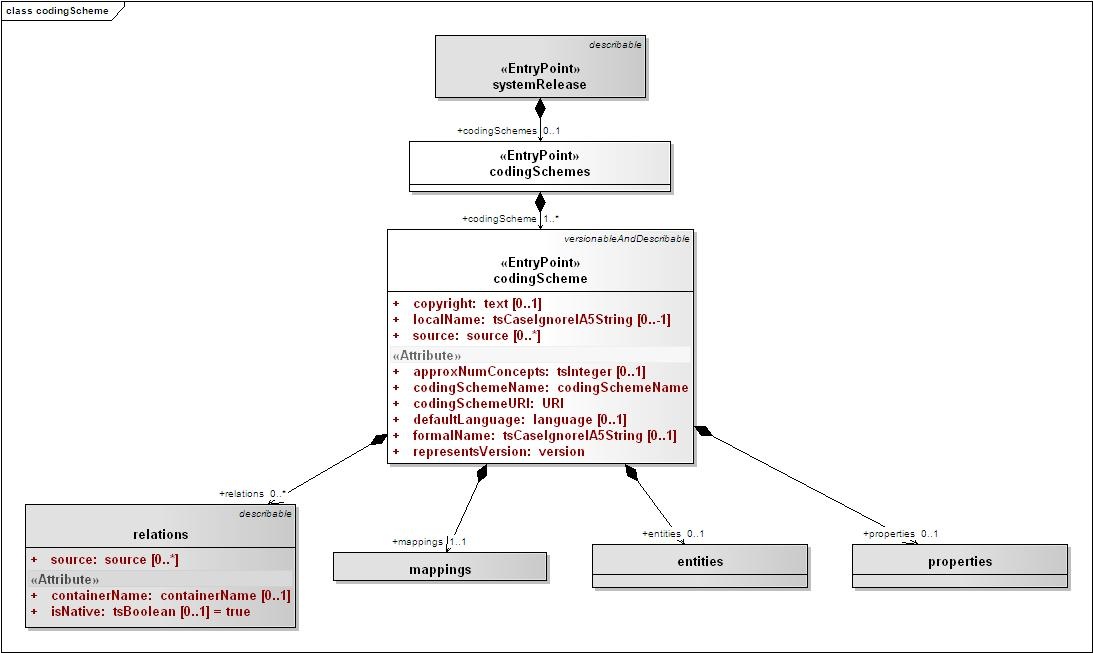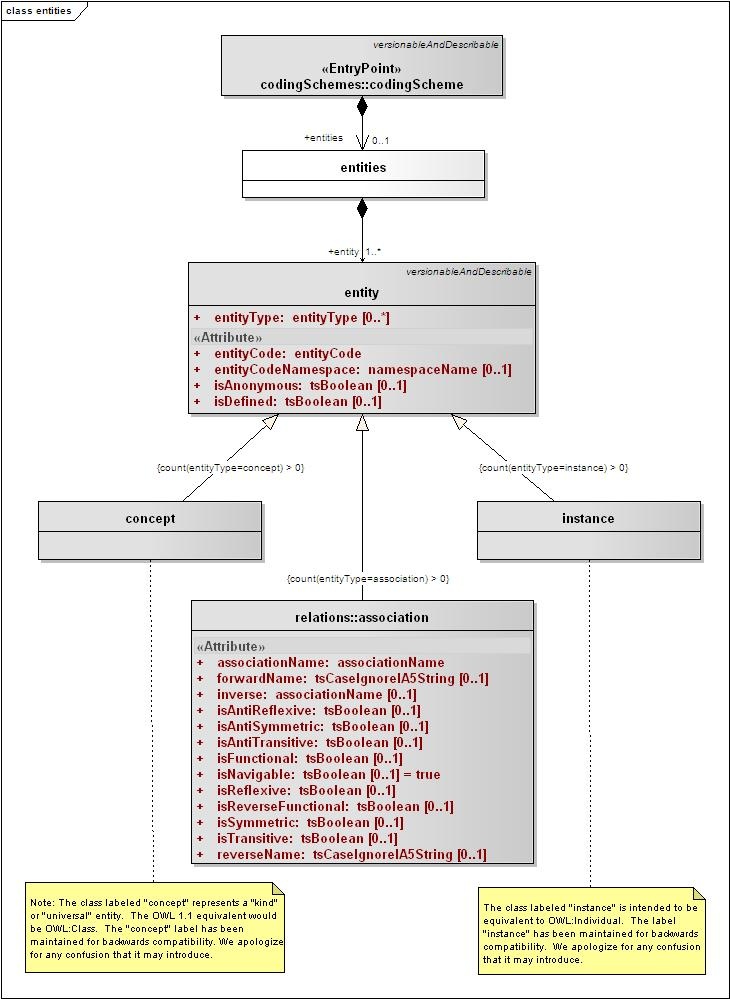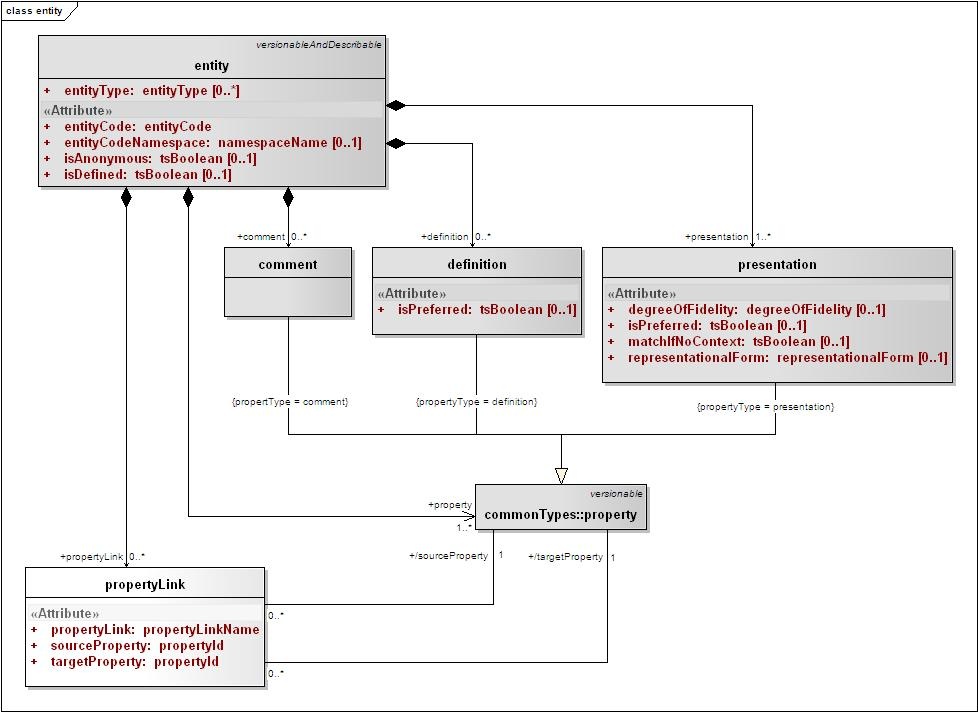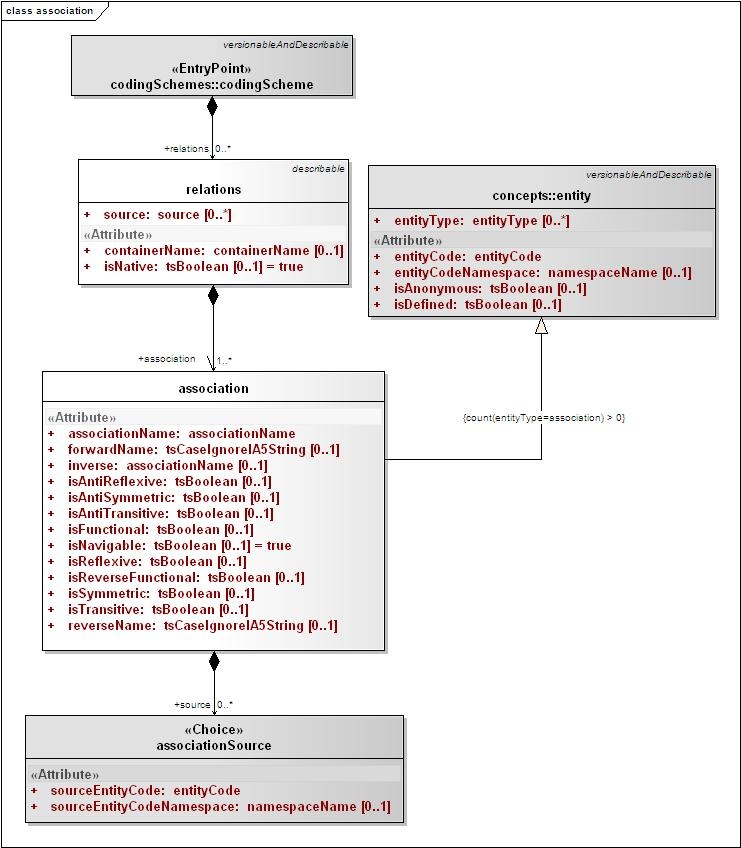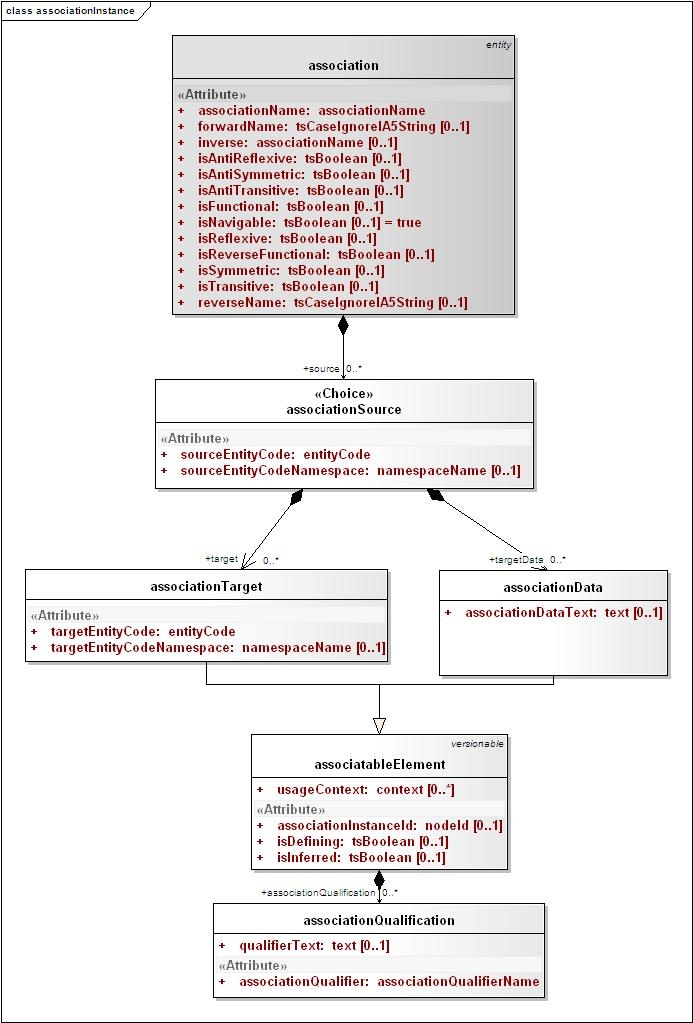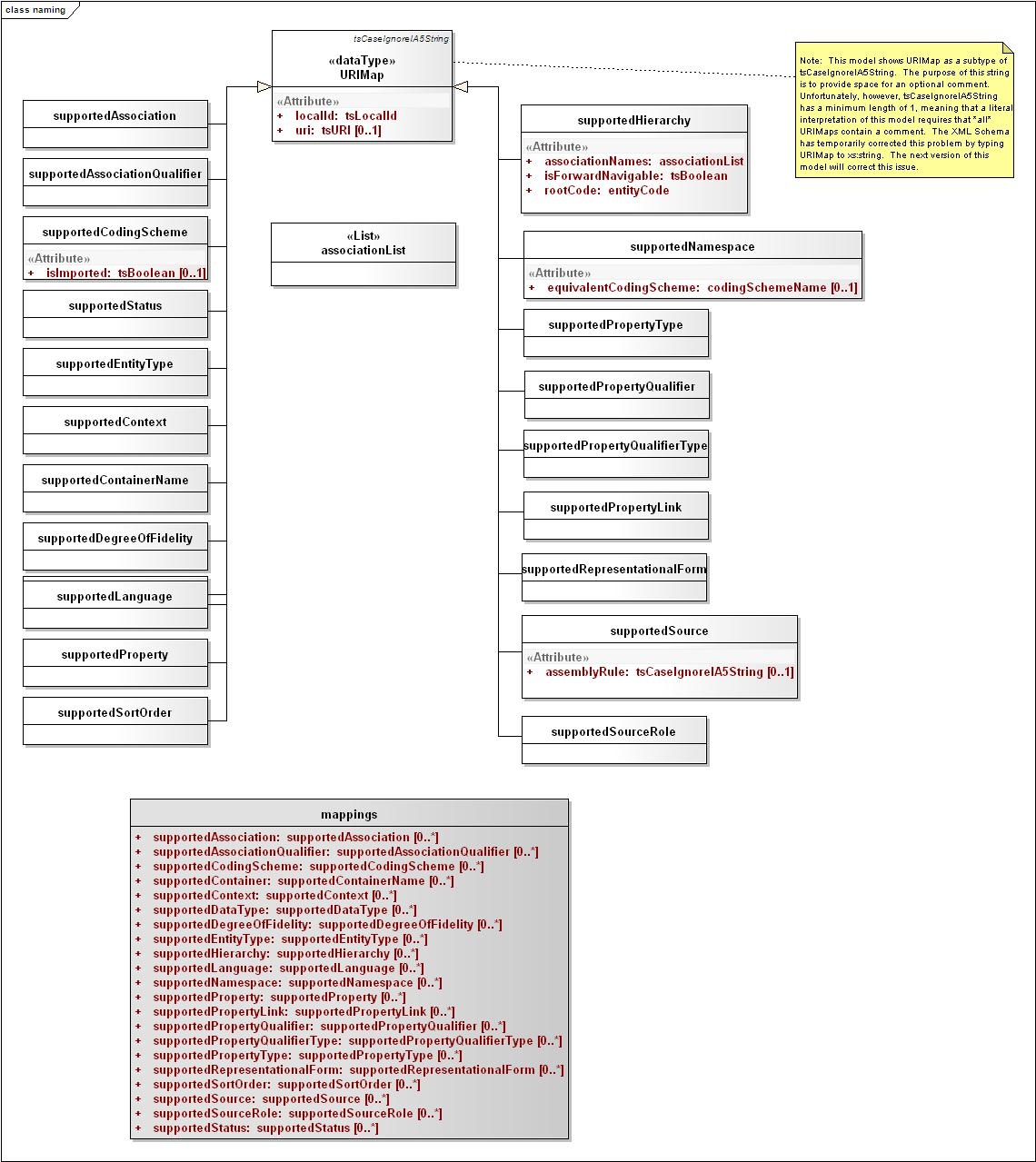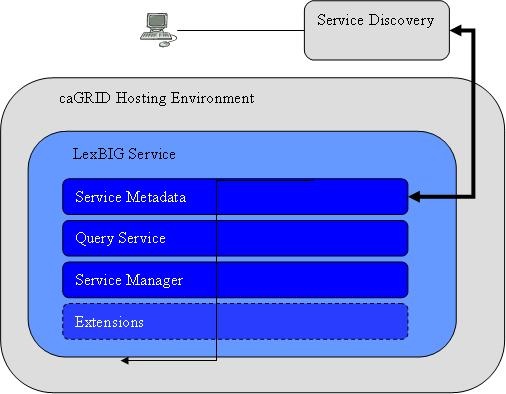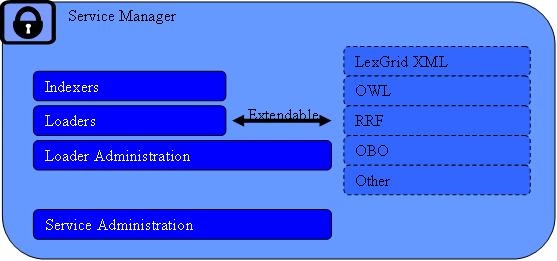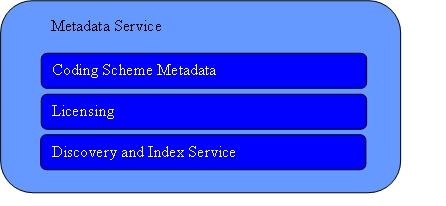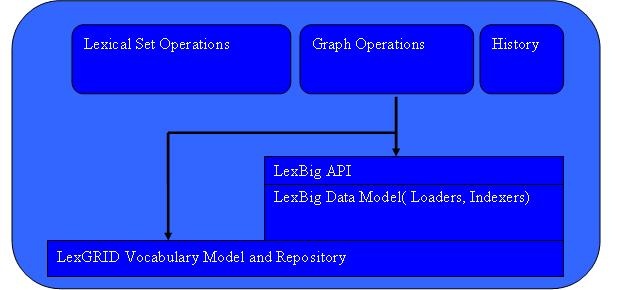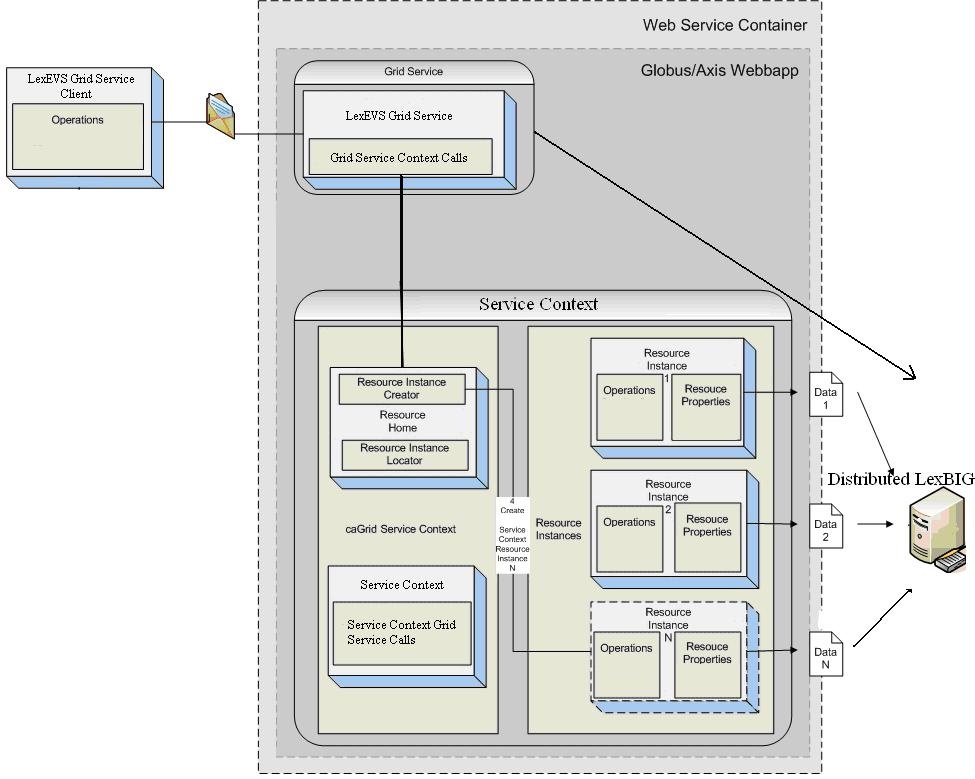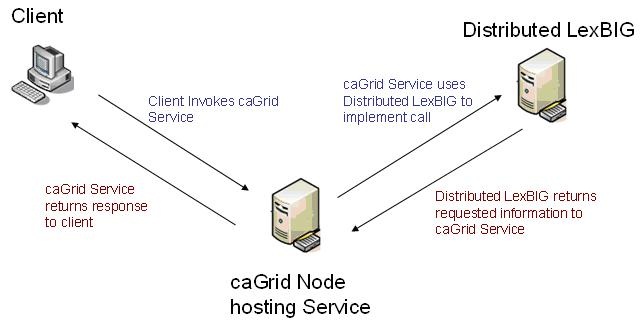 |
Page History
...
Note: Formal representation of the LexGrid and LexBIG models are discussed in VKC:Information Models.
Information Models
Overview
The information below is provided for introductory purposes. A full description of all available model components is also available in the javadoc distributed with the LexEVS installation package (see file breakdown in the LexEVS 5.0 Installation Guide). Since the javadoc is automatically generated and synchronized during the build process, it is recommended as the primary reference for use by LexEVS developers.
...
The LexGrid model is mastered in XML schema. The LexBIG project currently builds on the 2008 version of the LexGrid schema. A formal representation, showing portions of this structure that are of primary interest to the LexBIG project, is presented below. A complete version of the model is available at http://informatics.mayo.edu?page=lgm![]() .
.
CodingSchemes
The CodingSchemes branch of the model defines high level containers for concepts and relations. Each CodingScheme represents a unique code system or version in the LexBIG service. Components of interest include:
codingScheme
<u>codingSchemes</u>
A collection of one or more coding schemes.
...
A collection of properties.
codingSchemes
Concepts
Each concept represents a unique entity within the code system, which can be further described by properties and related to other concepts through relations.
conceptsAndInstances
<u>codingScheme</u>
A resource that makes assertions about a collection of terminological entities.
...
A binary relation from a set of entities to a set of entities and/or data. The entityType for the class concept must be "association".
entities
entity
<u>entity</u>
A set of lexical assertions about the intended meaning of a particular entity code.
...
A link between two properties for an entity.. Examples include acronymFor, abbreviationOf, spellingVariantOf, etc. Must be in supportedPropertyLink.
entity
Relations
Relations are used to define and qualify associations between concepts.
association
<u>codingScheme</u>
A resource that makes assertions about a collection of terminological entities.
...
An entity that occurs in one or more instances of a relation on the "from" (or left hand) side of a particular relation.
association
associationInstance
<u>association</u>
A binary relation from a set of entities to a set of entities and/or data. The entityType for the class concept must be "association".
...
A modifier that further qualifies the particular association instance.
associationInstance
Naming
These elements are primarily used to define metadata for a coding scheme, mapping locally used names to global references.
naming
<u>URIMap</u>
A local identifier that is used in a specific context (e.g. language, property name, data type, etc) and an optional URI that can be used to find the exact definition and meaning of the local id. Note: the string portion of this entry can be used to provide additional documentation or information, especially when a URI is not supplied.
...
A source role and athe URI of the defining resource
naming
LexBIG Model
The following extensions to the LexGrid model were introduced in support of caBIG® requirements. As with the LexGrid model, this document provides a summary of the most significant elements for consideration by LexBIG programmers. The complete and current version of the model is available online at http://informatics.mayo.edu?page=lexex![]() .
.
Core
LexBIG core elements provide enhanced referencing and controlled resolution of LexGrid model objects.
...
References a service in the Globus environment, this will be a global service handle (GSH).
InterfaceElements
Defines metadata related to model objects required by the runtime.
...
The combination of a system release and all of the entityVersions
that accompanied that release.
NCIHistory
Maintains a record of modifications made to a code system.
...
A change event as documented in ftp://ftp1.nci.nih.gov/pub/cacore/EVS/ReadMe_history.txt![]() . Note that date and time of the change event is recorded in the containing version. All change events for the same/date and time a recorded in the same version.
. Note that date and time of the change event is recorded in the containing version. All change events for the same/date and time a recorded in the same version.
Architecture
LexBIG
LexBIG Services
This section describes architectural detail for services provided by the LexBIG system. These services are geared toward the administration, management, and serving of vocabularies defined to the LexGrid/LexBIG information model. A system overview is provided, followed by a description of key subsystems and components. Each subsystem is described in terms of its overall structure, formal model, and specification of key public interfaces.
...
<tt>LexBIGServiceManager</tt> - The service manager provides a centralized access point for administrative functions, including write and update access for a service's content. For example, the service manager allows new coding schemes to be validated and loaded, existing coding schemes to be retired and removed, and the status of various coding schemes to be updated and changed.
caGRID Hosting
The LexBIG architecture provides the underpinnings LexBIG services to be made accessible through the caGRID environment in the future, where LexBIG services might optionally be deployed in a caGRID Globus container. caGrid provides a Globus service for service registration and discovery. LexBIG services deployed to the grid would be registered in the NCICB registry and be searchable through the NCICB index service.
Specification
Additional specifications related to the registration and discovery of LexBIG services in the caGRID environment will be included later phases of work in concordance with caGRID 1.0. This is will be coordinated with caBIG® Architecture workspace designees.
Service Management Subsystem
This subsystem provides administrative access to functions related to management and publication of LexBIG vocabularies. These functions are generally considered to be reserved for LexBIG administrators, with detailed instructions on how to secure and carry out related tasks described by the LexBIG Administrator's Guide.
...
- Lexical Match - for example, "begins-with" and "contains"
- Phonetic - allows for the ability to query based on "sounds-like" entry of search criteria.
- Stemming - allows for the ability to find lexical variations of search terms.
Index creation is typically bundled into the load process. Architecturally speaking, however, this capability is decoupled and extensible.
*Loaders
Vocabularies may be imported to the system from a variety of accepted formats, including but not limited to: - LexGrid XML (LexBIG canonical format)
- NCI Thesaurus, provided in Web Ontology Language format (OWL)
- UMLS Rich Release format (RRF)
- Open Biomedical Ontologies format (OBO)
As with indexers, the load mechanism is designed to be extensible from an architectural standpoint. Additional loaders can be supported by the introduction of pluggable modules. Each module is implemented in the Java programming language according to a LexBIG-provided interface, and registered to the loader runtime environment.
Metadata and Discovery Subsystem
This subsystem provides information about accessible vocabularies, related licensing/copyright information, and registration/discovery of LexBIG services.
...
Finally, the LexBIG architecture provides the underpinnings for LexBIG services to be made accessible through the caGRID environment in the future, where vocabulary services might be deployed and discovered within a caGRID Globus container. However, this portion of the API is preliminary and awaits coordination with caBIG® Architecture WS designees to determine exact recommendations and nature of LexBIG services on the grid.
Query Subsystem
This subsystem provides the functionality required to fulfill caCORE/EVS and other vocabulary requests. The Query Service is comprised of Lexical Operations, Graph Operations, Metadata, and History Operations.
...
History provides vocabulary-specific information about concept insertions, modifications, splits, merges, and retirements when supplied by the content provider.
LexEVS API/Grid Service Interaction
(DESIGN DOC IMPORT START)
Revision History
Content changes to this document from the previous to the current level are indicated by revision bars (|) unless a complete rewrite is indicated.
Date | Version | Description | Author |
|---|---|---|---|
07/29/2008 | 1.0 | Initial document | Kevin Peterson |
8/30/2008 | 1.1 | Revised for Security and Exception Handling | Kevin Peterson |
Note: If this document has been inspected, please indicate the inspection date that each version is based on in the "Change Description and Explanation" area. Entries in this log must be maintained for at least 3 years. |
Document Purpose
This document provides the detailed design and implementation of LexBIG Enterprise Vocabulary Service (LexEVS) caGrid Service. It should be noted that the LexEVS Grid Service is no longer part of the caGrid 1.1 infrastructure and will be deployed as a separate unit. This is a change from the previous release of the LexEVS Grid Service.
The LexEVS caGrid service will allow programs to utilize the caGrid 1.2 infrastructure to access LexEVS information that is currently being produced by NCICB.
Implementation Overview
Team Members
Table 1 - Team Members
Role | Name |
|---|---|
Development Lead | Kevin Peterson |
Documentation Lead | Kevin Peterson |
Project Manager | Tom Johnson |
Description
The LexEVS grid service will be used to obtain data accessible via the LexEVS service, specifically, the Distributed LexEVS services. Please refer to the LexEVS Programmer's Guide for more information.
For more Documentation, Build/Deployment instructions and examples, visit the project documentation home at: http://gforge.nci.nih.gov/docman/index.php?group_id=491&selected_doc_group_id=3749&language_id=1![]()
Scope
The LexEVS Grid service will provide programmatic access to the LexBIG domain objects that are available via the LexBIG information model.
...
Context | caBIG |
Classification Scheme | LexBIG |
Version | LexBIG_v2_3_rv1 |
Architecture
The LexEVS Grid Service is implemented to expose the API and Model of LexBIG 2.3. For more information on LexBIG, see http://informatics.mayo.edu![]()
...
Below is the LexEVS Grid Service Architecture, viewed from inside of the Web Service Container. For more information on how Service Contexts and Resources are used, see the "Service Contexts and State" section below.
LexEVS Grid Service Class Diagram
The LexEVS Grid Service is built on the LexGrid/LexBIG model and implementation.
For more information about this model, visit (LexBIG) https://gforge.nci.nih.gov/plugins/scmsvn/viewcvs.php/LexBIG_Core_Services/LexBIG-2.3/lexbig/lbModel/?root=lexevs![]()
and (LexGrid) https://gforge.nci.nih.gov/plugins/scmsvn/viewcvs.php/LexBIG_Core_Services/LexBIG-2.3/lgModel/?root=lexevs![]()
...
For information specific to the LexEVS Grid Service, visit: https://gforge.nci.nih.gov/plugins/scmsvn/viewcvs.php/LexBIG_Core_Services/LexBIG-2.3/lexbig/lbModel.cagrid/?root=lexevs![]()
This link contains Class Diagrams and descriptions for input/output parameters, as well as other information concerning the Silver Level Compliance submission package.
LexEVS Grid Service Sequence Diagram
The sequence diagram for the operation "getSupportedCodingSchemes" is described below:
...
General Call Sequence Example:
Assumptions
- The LexEVS service will be based on the latest LexEVS 5.0 release.
- The LexEVS Grid Service will not have any method level security. All security requirements will be handled by the actual deployment of the underlying LexEVS 5.0 service. Please see the "Security" section below for more information on how the LexEVS Grid Service utilizes this security.
- The LexEVS Grid Service will not be deployed as a "core" service by caGrid at NCICB as was previously done, but rather will now be deployed as a standalone service.
- The LexEVS Grid Service release schedule will no longer be coupled to the caGrid deployment schedule as previously done.
- Multiple version of LexEVS Grid Service may be active at the same instance in time depending solely on the availability of the underlining EVSAPI service.
Dependencies
- LexEVS 5.0 service needs to be available and running correctly.
- The LexEVS service and operations will use the Introduce toolkit to generate the appropriate structure for registering the service into caDSR.
Third Party Tools
- Introduce Toolkit
- Globus Toolkit (4.0.3) or appropriate version supported by caGrid 1.2
- caGrid 1.2 core infrastructure
Server
The LexEVS Grid Service will be deployed as a "stand alone" grid service at NCICB.
APIs
The main Service API exposed by the LexEVS Grid service will be the http://informatics.mayo.edu/LexGrid/downloads/javadocGrid/org/LexGrid/LexBIG/cagrid/interfaces/LexBIGServiceGrid.html![]() Interface. All other APIs will not be directly exposed, but will be made available through Service Contexts.
Interface. All other APIs will not be directly exposed, but will be made available through Service Contexts.
In General, API calls will follow this sequence:
API Examples
For an example clients, service calls, and SOAP messages, see http://gforge.nci.nih.gov/docman/index.php?group_id=491&selected_doc_group_id=3880&language_id=1![]()
...
Searching for concepts in NCI Thesaurus containing the string "Gene"
:SearchingForConcepts_Snippet
Service Contexts and State
Along with the Main Service (described above), the Server will also host the following Service Contexts. These Service Contexts are not meant to be called directly as Grid Services. The main function of these Service Contexts is to provide additional functionality to the Main Service.
...
6. These API calls are separate calls but statefully maintained on the server via the Resource.
Error Handling
Error Connecting to LexEVS Grid Service
...
Service Context Services are not meant to be called directly. If the client attempts to do so, an org.LexGrid.LexBIG.cagrid.LexEVSGridService.CodedNodeSet.stubs.types.InvalidServiceContextAccess Exception will be thrown. This indicates a call was made to a Service Context without obtaining a Service Context Reference via the Main Service (see the above section Service Contexts and State for more information).
Client
The Introduce toolkit generates a "client" class that will be provided to the users.
Security Issues
Security in the LexEVS Grid Service is implemented in the Distributed LexBIG layer. The information in this section explains how the LexEVS Grid Services utilize this security implementation. For more information about the Distributed LexBIG Security Implementation, see this documentation: http://gforge.nci.nih.gov/tracker/download.php/366/1462/10884/4060/Distributed_LexBIG_%20AccessTo_Licensed_Vocabulary_implemenation.doc![]()
...
All non-secured information accessed by the LexEVS Grid Service is publicly available from NCICB and users are expected to follow the licensing requirements currently in place for accessing and using NCI EVS information.
Performance
The LexEVS service will take advantage of all improvements made to the LexEVS API services with the exception of lazy loading. LexEVS grid service, being in nature a web service is currently not taking advantage of lazy loading since objects are transferred as fully populated objects. However, future releases of LexEVS Grid Service may refractor the interface in such as way as to take advantage of some of the benefits brought about by the inclusion of lazy loading in to LexEVS API service.
LexEVS Grid Services utilize the performance enhancements of the LexBIG API.
For more information about LexBIG performance (which LexEVS Grid Services are dependent on), see http://informatics.mayo.edu![]()
Installation / Packaging
The service will be installed and deployed as a "stand alone" service at NCICB.
Migration
Both the current version of LexEVS grid service may be "in service" simultaneously if the corresponding underlying EVSAPI service is also "in service" to manage migration of clients.
System Testing
See LexEVS Grid Service Testing Documentation at: http://gforge.nci.nih.gov/docman/index.php?group_id=491&selected_doc_group_id=3879&language_id=1![]()
...
TITLE | NAME |
|---|---|
Technical Writer |
| Panel |
|---|
LexEVS Loader Source Mapping
This section is now moved to separate pages to provide details on how different formats are loaded into the LexEVS model.
- For LexEVS v5.0, see LexEVS v5.0 Loader Source Mapping.
- For LexEVS v5.1, which includes enhancements to the loader framework, see LexEVS 5.0 Loader Source Mapping.
...
| Scrollbar | ||
|---|---|---|
|
